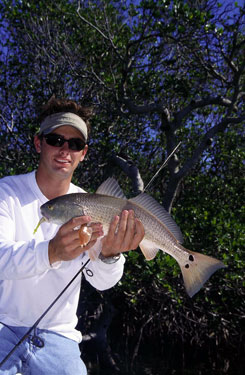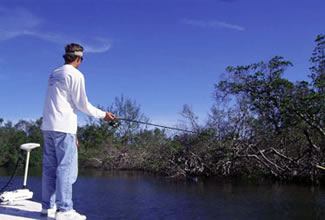May 16, 2011
By Mike Holliday
Redfish roam the shorelines and creeks near this Southeast Florida town

Jumbo snook add excitement for redfish anglers spring and summer. |
This first 100 feet or so never has any fish in it,” said Charlie Johnson, with a relaxed attitude that only comes from hundreds of fishing hours in a single location.
It wasn't really what I wanted to hear.
After shutting the boat down along the edge of the channel and poling several hundred yards into a nondescript cove of mud and mangroves, I felt like we'd done all we could to follow the silent and deadly routine. I was ready to see fish. Redfish in particular.
“Get on up past that point, and we'll start to see some small schools. In this area they like to sit in the small, sparse patches of dark grass.”
For such a mellow personality, I was startled to see that Johnson takes his fishing so close to heart. He set the hook too early on a circling red that tried repeatedly to grab his fly; Charlie had worried that the point-blank red would spot our boat. I couldn't believe he was so hard on himself. After all, it was the first fish of the day.
With Charlie muttering about no second chances and a limited number of shots, we slowly inched our way down that shoreline and it only took moments for the next fish to appear.
“Charlie, in tight, just behind the boat,” I said with as much sense of urgency as I could load into a whisper. “He's facing the mangroves.”
“Got him,” said Charlie, who then cast to the fish's tail.
I expected a litany of “gosh darns,” or maybe something a little stronger, but before words could surface, the slot-size redfish spun around and lunched on his offering.
“Hmmm...,” said Charlie, beaming over his singing reel. “I didn't expect that to happen.”

Redfish are available throughout the year along the mangrove shorelines. |
Neither did I, for that matter, but I would take it just the same. It meant I was back on the pointy end of the boat and Charlie was on the stick. A Vero native, he knows this area very well—and I was ready for someone to show me where the fish hide.
From that small cove we worked north, fishing spoil islands or mud and oyster banks that Johnson picked out in a process that was far from random. If I pointed out a particular location as looking fishy, he knew exactly how much time he'd wasted hunting redfish in that very spot. Or how school trout just ate him up and how he'd wasted a previous morning on fish there, with not one fish pulling line off his reel.
The proximity of the town of Wabasso puts it close enough to Sebastian that many anglers pass it up while heading for Sebastian Inlet, which is good news for local fish hugging the shoreline. Quite often, anglers fishing Sebastian don't even realize they're in Wabasso until they see SR510 (Wabasso Causeway) in their path.
Just north of Riomar, a small town on the northern end of Vero Beach, and up past the Grand Harbor development on the western shoreline, the best water comes into play along a stretch of about a mile of mangrove-lined islands, creeks and coves. When the tide gets moving through these areas, it really flushes baitfish that predators ambush.
Some of the best places to fish are sandy cuts through the islands that are less than two feet deep, but have small depressions or holes that allow trout and reds to rest out of the current, yet remain directly in the path of oncoming food. That makes bait an easy target.
These areas can be difficult to fish because of the current's strength, which can move a boat faster than a trolling motor, especially during strong tides when fishing is best. Approaching the cut from downcurrent and casting upcurrent is a common strategy, but it can limit the angler's casting area because the boat can't work its way up the cut. A better method is to fish downcurrent, holding the boat tight to the mangroves, away from where the current is strongest. The boat will still lose ground, but usually at a pace that allows anglers to pepper the spot with enough casts to feel like they've taken a good shot.
Backwater creeks and mud coves in this area are prime shrimp habitat, as are grassflats along the western shore. Shrimp are the primary food source in the area, especially during winter and spring when they're being pulled from the shallows toward the inlet. For this reason, live shrimp are hard to beat for just about any gamefish. Freelined or fished under a cork, they're deadly on trout and snook. The locals here like to use something a little different, what they call a “shrimp and booger” combination for redfish. It's not as bad as it sounds, made by breaking off a single joint of shrimp, peeling off the shell and sliding the meat onto the hook and up toward the eye. A live shrimp is then pegged to the business end of the hook. The “booger” adds scent to the water and allows redfish to home in on the entire shrimp.

Wading birds indicate bait and extreme shallows. |
South of the Wabasso Causeway near Hole-in-The-Wall Island, the Intracoastal Waterway (ICW) takes a turn east to avoid shallows in that area. As the ICW runs past several islands, it touches a group of small openings that lead into shallow coves and cuts through islands that are home to the area's redfish population.
The east side of Indian River is dotted with small coves that join creeks or portions of the river separated by islands, along with large areas of canals, deep holes and hidden bays in the middle of islands, somewhat like urban Southwest Florida. Meanwhile, the west side of the river is one long shoreline with an occasional point of land or small canal.
The terrain is so different from one side of the river to the other, styles of fishing each side differ substantially. Most anglers wade, idle or ease along with trolling motors on the west shore. On the east shore, they really hug the mangroves. Even though the topography on each side is different, you'll find redfish, trout and snook in about equal numbers.
I found out how good it can be on the west side of the river one day about eight years ago, when fishing with a guide out of Stuart who brought me “up north” just because I needed to see the show. Launching at the ramp on the south side of Wabasso Causeway we headed south, fishing grassy areas with large sand banks. The reds worked their way down the grassy edge of the sand, never moving over the sand but always close enough to dart out onto the bar if a shrimp or crab popped up.
We were throwing crab flies, and tried to cast close enough to fish that they could hear the plop of fly hitting water. The red would turn, locate the fly and lunge for it. Twice I had redfish pin the crab so hard against the bottom that I had trouble setting the hook with my seven-weight outfit. Each fish blew the fly out of its mouth and swam away in a huff.
Over the course of a morning we found singles, pairs and triples, and then one big school of maybe 50 fish waking across a flat, heading south on matters of importance, a sight to see. Along with redfish that day were assorted trout and several nice snook.
Later in the day, we moved to the spoil islands in the middle of the river, where we cast shad-type jigs at the mangroves for redfish and under-slot snook. At one island we let the jigs swim off the shore and then sink into a deep hole that was full of school trout. The fish averaged two or three pounds, but at one point we had 16 casts in a row that got a strike or caught a fish. We also pulled a respectable flounder off the mangroves that blasted the jig just after it hit the water.

Accuracy is paramount. Skip baits into shallows below overhanging branches for consistent hookups. |
In warmer months, local grassflats just beg for a topwater plug, although I've seen them produce huge trout in the middle of winter. The grass is dotted with sand and shell potholes that hold some of the largest trout on the planet, along with snook, ladyfish and other gamefish. During fall, redfish school up and move across the flats. On a good day an angler can chase four or five different schools, and catch several fish from each.
Wabasso offers some great fishing for anglers drifting or using a trolling motor, but the best way to fish the area is by small skiff, with someone on the poling platform inching the boat along the shoreline. This silent approach allows the bow angler to sight-fish. By slowly creeping down the shorelines or up into shallow coves, anglers can find fish at the ambush points.
For fly fishermen after redfish, this type of stalking and sight-casting to tailing or tipping redfish is the ultimate fishing challenge, very addictive. Strikes can be spectacular, along with classic failures. Fortunately, redfish have short memories, so a denial can be followed up with another cast that may knock the feathers off that very same fly.
Good sunglasses, clean water and a nice calm day won't always mean you'll encounter redfish in Wabasso, but it does guarantee a colorful day on the water with a variety of terrain. Put in the time and eliminate the spots that don't hold fish, and you will find fish in this area.
Launching Limited
In early February the boat ramp at the Wabasso County causeway park was functional, but without a dock; there were only a few pilings left, thanks to last year's hurricanes. Repairs have been slow. It's tough to climb onto larger boats launching here, when you don't have a dock. There is also a ramp at Sebastian Inlet State Park, but no docks.
Wabasso Tackle Shop has full service and can be reached at (772) 589-8518. They're located on U.S. 1.
This particular coastal region can be studied on Florida Sportsman chart Number 05, which covers Melbourne to Vero Beach.
FS
Advertisement
